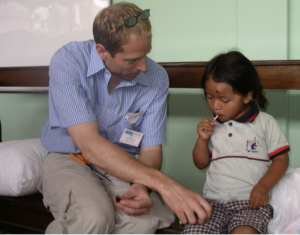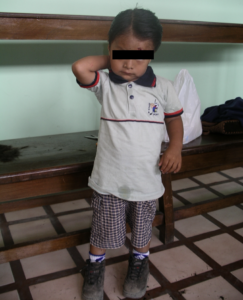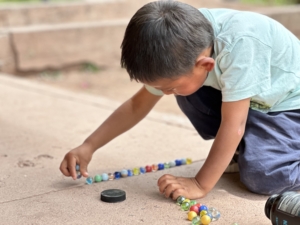 Despite these many years, one thing about our work in Perú that always surprises me is the constant opportunity for learning. In 2011, on an outreach trip to provide medical care to an underserved area in Lima, I had one of those “life moments” that will always stay with me. The story goes like this: On Saturday morning, the day before we completed the outreach campaign, I was up by 6 a.m. to pack the remainder of the team’s medications and prepare for the respective distribution sites.
Despite these many years, one thing about our work in Perú that always surprises me is the constant opportunity for learning. In 2011, on an outreach trip to provide medical care to an underserved area in Lima, I had one of those “life moments” that will always stay with me. The story goes like this: On Saturday morning, the day before we completed the outreach campaign, I was up by 6 a.m. to pack the remainder of the team’s medications and prepare for the respective distribution sites.
After a quick breakfast of coffee and pineapple, I had a patient to see for a follow-up visit. The patient, a 4-year-old boy, was coming back to get a few stitches removed from his forehead. On Monday, his mother brought this little boy into the clinic after falling on a rock. It is important to remember that we were conducting our clinic operation in one of the most impoverished neighborhoods of Lima. This was such a poor area that we were in tents to see patients. Most of our concerns were not directed toward this subtle inconvenience but rather toward the fact that the Peruvian healthcare system was on strike.
“On strike!” What does that mean? In a world of limited resources and even more limited opportunities, the best way to negotiate change is to stop working. As such, all doctors, nurses, technicians, and dentists within the Ministry of Health stopped working. This included emergency services as well. It’s not hard to realize this left us in a rather tricky and challenging situation. Alas, the key to success in life is flexibility; we trudged forward despite our “inconvenient” limitations. It’s a good thing we had an emergency room physician on the trip.
Saturday’s “visit” worried me. I was concerned about how our little friend would respond to my taking the sutures out of his noggin. On Monday, he was hysterical, and we struggled to comfort him while we placed sutures. We then sent him to the local health post for a radiograph of his skull (to rule out a fracture) and another clinic for a tetanus shot. This sounds like a simple series of follow-ups, but it became more than a dozen phone calls between the project director and the hospital. It also involved an equally impressive number of visits with the mother and her son and a frustrating experience interacting with a very fragile healthcare system.
Finally, on Saturday morning, he came to see me with a broad smile and a swollen forehead. I neglected to mention one crucial detail in this story—the little boy did not look like a stereotypical little boy. He had long hair and a cherubic face, and his shy demeanor gave him a tender and gentle appearance. I asked the project director about the significance of long hair on male children, and she told me of an ancient Andean tradition.
As the story goes, the tradition is to wait for the “right” time to cut a child’s hair. The project director said that the “right” time was determined by the people in a young boy’s life, who could help and instruct him in the world’s ways and act as role models.
This young boy (we will call him Roberto) did not yet have the “right” people. His mother was widowed. She was without a job and had sole responsibility to care for two other children (including a young baby). She was one of the many people we encountered who lived in an area without water, waste disposal, or electricity. She told us that she had been waiting for the boy to get another father before she cut his hair. She told us she was waiting for Roberto to meet a man who could mentor and guide him in his life.
As luck would have it, removing the sutures was easy. Roberto squirmed and cried, but he was okay. After we gave his mother antibiotic cream and a few pieces of candy for Roberto, the mother asked if I would cut his hair.
I was incredibly flattered. I hesitated initially, recognizing that I was venturing toward a solemn responsibility – the man cutting the child’s hair is also the godfather. In the end, my hesitation was only momentary. I cut that boy’s hair with all the love and compassion (albeit very little skill) I could muster.
This act produced a lofty natural high for me. I was walking in the clouds. It is a humbling experience to be part of the lives of the people we serve. It is even humbling to think I had an impression on their lives—even if that impact only assures they have the best haircuts in Latin America.
 I’ve always wondered why the best things in life are so hard. I’m not talking about a simple investment of x amount of energy; you should expect y amount of outcome. No, I am talking about the hard that pushes oneself to extremes, the pushing that makes you want to give up.
I’ve always wondered why the best things in life are so hard. I’m not talking about a simple investment of x amount of energy; you should expect y amount of outcome. No, I am talking about the hard that pushes oneself to extremes, the pushing that makes you want to give up.
 Despite these many years, one thing about our work in Perú that always surprises me is the constant opportunity for learning. In 2011, on an outreach trip to provide medical care to an underserved area in Lima, I had one of those “life moments” that will always stay with me. The story goes like this: On Saturday morning, the day before we completed the outreach campaign, I was up by 6 a.m. to pack the remainder of the team’s medications and prepare for the respective distribution sites.
Despite these many years, one thing about our work in Perú that always surprises me is the constant opportunity for learning. In 2011, on an outreach trip to provide medical care to an underserved area in Lima, I had one of those “life moments” that will always stay with me. The story goes like this: On Saturday morning, the day before we completed the outreach campaign, I was up by 6 a.m. to pack the remainder of the team’s medications and prepare for the respective distribution sites.
